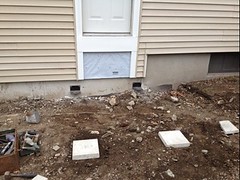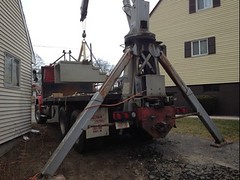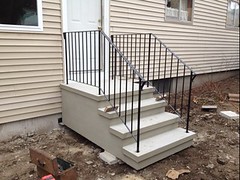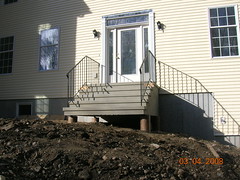Overview of a precast stair installation.
If you are considering replacing stairs on an existing home, this post should give good insight as to what the process involves.
Preparation
Truck access is very important. There is no need to begin removing your old steps until you are sure that we can get our truck in to install the new steps.
Things to keep in mind are:
- low tree branches that have to be trimmed
- know the location of your septic tank (our truck cannot drive over it)
Obviously the very first part of this procedure would be to remove the old steps. We remove them using a mini excavator or of you are in a tight spot, we can also remove them by hand.
Removal of the old steps may reveal that the wooden sill under the house is rotted due to constant exposure to moisture. If this is the case, the best time to repair it would be after the old stairs are removed. Depending on how bad the rot is, a carpenter may be needed to repair the area. It might help to have a carpenter lined up if you think you might have a problem with rot.
Installing precast stairs
-
Steel brackets are bolted to the foundation using concrete anchors. These will be used to catch the legs at the back of the stairs.
-
Small concrete pads are set under each side of the steps toward the front of the unit. These pads are set slightly lower than the brackets so that the stairs are pitched forward for water run off
-
The precast stairs are then set on the brackets and pads using a boom truck. Solid steel shims are used to make small adjustments if necessary.
-
If your stairs require railings, they would be installed at this time. The railings are installed in the precast unit and held in place with anchoring cement.
Of course not every situation allows for this type of installation. We an use other means such as a large concrete pad or frost footings if the situation requires it.
Contact us and have a professional come out to evaluate the best step for your situation





